|
Papua New Guinea was a very different place before Independence.
A fascinating place filled with unbelievable characters and real achievers. It had a unique history from the days when the British ran Papua and the Germans ran New Guinea; The Gold Rush era of the 20s and 30s and the Japanese invasions in WW2.
Earthquakes and torrential rain, birds that were totally unique to PNG, over 700 different languages and groups of natives, who had lived there for thousands of years, beautiful islands and coral reefs, volcanoes and 15,000 foot mountain ranges—it was different all right.
A most interesting and dangerous place to fly aircraft in. Many airstrips (steep, rough and slippery) were over 5000 above sea level: one was at 8000 feet above sea level.
Enjoy this taste if you haven’t been there. Those of you have have lived and worked in Papua New Guinea, take a short trip back in time and reminisce with me.
For those not in the loop, Sypho, GCS and Syphers are the one bloke: yours truly,
Click on a thumbnail photo to see the full size version.
 |
|
The famous Wau airstrip, 1966. This airfield was built by gold mining pioneer Cecil Levien in 1927. The first landing was by “Pard” Mustar in a de Havilland 37 belonging to Guinea Gold Airways, Lae. Shortly thereafter many aircraft types, including the giant Junkers G-31 tri-motors were landing huge loads at Wau in support of the mining operation here and up at Edie Creek (centre above the cloud base). At 3475 feet above sea level and with almost a 10% slope, it was an ideal New Guinea airfield. During January 1942, Japanese forces from Salamaua and via the Black Cat Gap attacked Wau and were defeated by the Australian Kanga Force. The Japs got to the bottom boundary of the drome and Australian soldiers, landing in DC-3s with artillery, pushed them back. |
 |
|
Sypho (that’s Syphers) in Talair C/185 VH-GKC near Omkalai, 1966. That’s the Wahgi River down below. Photo by Garry Honour. |
 |
|
The Asaloka Gap,near Goroka, 1966. A minimum altitude of 7600 feet was advisable to comfortably get through, using correct New Guinea bush flying technique. Always use the oblique approach when crossing a gap.
With a downdraught, engine failure or misjudgment, you can more easily turn away, a shallow turn rather than a full 180 degree turn. Such gaps, when almost clouded in (imagine only the sharp V being open here), could be very tempting to try to fly through.
Many fatal crashes happened because pilots took the chance. There are some big mountains around here: nearby Mt Wilhelm is 14,793 ft high. |
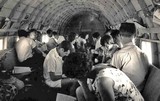 |
|
New Guinea style travel in a side saddle DC3, 1966. Noisy and quite cold above 10,000 feet. Freight was tied down in the middle, also providing seating.
When practical common sense was not diminished by stupid OH and S regulations. |
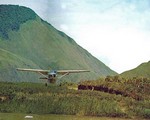 |
|
Rough country. Cessna 185 landing at Marawaka. Like Wonenara, it is the land of the Kukukukus, the most feared tribes in New Guinea. |
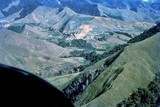 |
|
Wonenara airstrip, north of Marawaka and north of the Kratke Range. Poison arrow country. |
 |
|
Wonenara,1966. Canadian pilot Charlie Weir. The strip was very tight after take-off, if heavily loaded. |
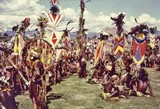 |
|
Goroka Show, 1966. Bikpela Sing Sing. The Australian Governor General, Lord Casey, showed up in a three-piece swallow tailed suit, complete with top hat. He wore many rows of campaign ribbons, gongs and medals.
The locals looked at him and said “Emi i-wanem samting?” (What is this?) Casey’s speech went along the lines of “you Australians are taking great risks being here, especially to your health”. He must have been referring to the Aussie Expat’s beer drinking habits.
When the Kukukukus displayed, a great hush fell over the showground. |
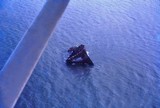 |
|
The WW2 Japanese wreck, Tanyo Maru, off Lae's runway end. Airliners with radar (DC-4s and Lockheed Electras) used it to get to the threshold of Runway 32 in minimum visibility and very heavy rain.
|
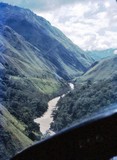 |
|
Flying down the Wahgi River, 1967. |
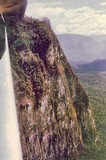 |
|
Cliffs never far away, the Cessna 185 is cruising at 10,000 feet above sea level. 1966
|
 |
|
Frank Fudge, OIC, Goroka Tower, 1967. A Brit with a quiet sense of humour. Very proficient at his job. He was also quite flexible regarding VFR and bad weather.
This depended on the experience level of the pilot. Some of the older DC-3 Captains had open slather. Do what you like in the morning fog. Steep turns, close to the deck and other spectacular flying. |
 |
|
Macair Cessna 185 on take-off Obura, 1968. A turn soon after take-off was logical SOP. |
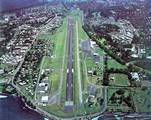 |
|
Lae aerodrome, 1969. |
 |
|
GCS and a C/185 called Dim Sim at Derim, Morobe Province 1970. I conducted the first landing here when the aerodrome opened in January 1970. About five minutes' flying from Kabwum. Or five days' walking. |
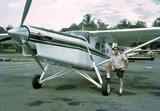 |
|
Ross Shepherd and the Macair Pilatus Porter,Lae 1970. A great bush pilot and an old friend. When Ross was 15, he was taken to the front gate of a Brisbane orphanage, handed a ten shilling note and told “you are on your own now, Ross”. (They at least shook hands.)
Very astute, hard working and a great judge of character, he prospered. He has owned fishing trawlers in the Gulf and a large fleet of bulldozers.
He owned aircraft, trucks, earth scrapers and motels, but you would never know it, when talking to this Winton bushie. He was watching you, and was miles ahead of your thinking. |
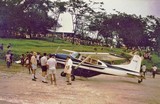 |
|
Dim Sim at Kabwum, ca. 1970. GCS in khaki shirt, brown shorts. Ian Rolls is barefooted, with back to camera (he always flew in bare feet) Kiap on the RH side is John Absolem. Their good wives behind.
Ian died in a bad weather C/185 crash near Siwea and John disappeared at sea (in a tinnie) trying to attend a government meeting in Alotau, Milne Bay. He departed Esa’ Ala on Normanby Island. He had several cans of petrol aboard and he was a chain smoker.
I flew 13 hours in one day—on low level search for John—in a Twin Otter, with no joy. Ian and John were very close friends of mine: weddings, get-togethers at Kabwum, Lae or Wasu on the coast, fishing and even serious beer drinking.
The Ben Hur type crowd in the background was then completely normal, at any aerodrome in Papua New Guinea. Under the fast changing circumstances, I could totally appreciate their curiosity. Twenty years earlier, western progress and ways had not burdened them whatsoever. |
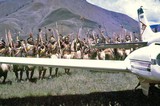 |
|
Morobe District Commissioner Bill Seale's send off, at Menyamya, with Kukukukus (very dangerous fellows). This final tour was a four day extravaganza. Each night we would fly back to Lae with a serious load of valuable artifacts. even took a back panel out to allow long spears into the rear fuselage (properly secured). Next day, we hit a different area, and the Kiaps were organised. At Wantoat the local Kiap had excelled and exceeded all expectations. He had organised thousands of locals to dress up and be ready for a Sing Sing when the Bikpela Man went past. DC Seale, his wife and I were bundled onto the back of a Land-Rover, which even had pipe hand bars to grip. As the Kiap drove the Land Rover up and down the lanes of assembled natives—resplendent in their feathery ancient costumes—I was amazed at the crowd, the cheering and the waving of hands. We all waved back. I felt like Royalty on a Coronation Tour. All totally undeserved.
Perhaps it was my immaculate Macair uniform that struck them: the black epaulettes and gold bars were really good. Old Bill looked somewhat ordinary—or so I thought. |
 |
|
On final approach. Kabwum aerodrome. Mount Sarawaket is in the background: 13,520 feet. This aerial viewpoint is between a narrow area, bounded by two vertical cliffs, higher than the aircraft is here.
Lots of scares, embarrassing arrivals (one mission pilot overshot this field and demolished his new C/206 alongside a native’s bush hut), many more serious prangs and several fatal accidents around here.
One aircraft totally disappeared on a ten-minute flight. Not found to this day. Vale Cec. Most of the scares were about going into cloud at an inopportune moment, way below the surrounding terrain. |
 |
|
Macair Beech Barons. Bob Dot-feet Dorling, left, and Robin Hunting-dog, RH, at Asek, 1969. The Army was also here this day. his place could get very slippery and foggy.
One spectacular attempt at a go-round here—in a Cessna 206—didn’t quite make it. Wings torn off, fuselage broken off just behind the rear seats, the cabin completely bent out of shape, they were very lucky to all get out alive. I recall he had about 8 persons on board.
The very experienced pilot went IFR, turning inside the steep ridge (centre, top). Not a good place to find yourself in the soup.
|
 |
|
The old strip, Porgera, Western Highlands. This aerodrome was 7200 feet amsl, slope 10%. |
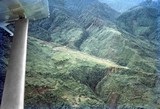 |
|
New Guinea style. Kasanombe airstrip from Macair Pilatus Porter, Morobe Province, ca. 1970. An inexperienced pilot in Cessna 206 was on final approach here, when got an HF radio call: ”No strip report for Kasanombe aerodrome received yet”.
He immediately attempted to go around and turn left. Why? Surely, simply land and argue about it later. After crashing into the mountain above the strip, the aircraft rolled downhill and rolled itself into a ball. The shaken neophyte walked away unhurt. |
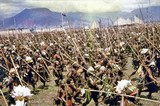 |
|
The Chaps, Mount Hagen Show, 1968. The Australian flag proudly flying.
|
 |
|
Salamaua isthmus and airstrip. A thriving township and port before Lae came into being. Quite a famous place that serviced the Wau Goldfields via the Francisco River and Black Cat Gap, initially on foot in the 1920s.
Errol Flynn was here (spent some time in the local calaboose). He had no money and was even then known as a serious spiv and con-man. Not to mention womaniser.
The airfield was used from the late 20s, through the 30s and was captured by the Japanese March 1942. Heavily bombed by the USAAF and RAAF and attacked by infantry, the original town was obliterated.
It was my privilege to be involved in the survey and reconstruction of the aerodrome, along with DCA’s Jack Adame. I did the initial landing on the newly built airstrip in August 1970. |
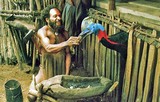 |
|
Southern Highlands. A Mendi man and his Muruk, or Cassowary. |
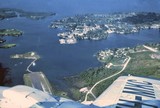 |
|
Madang. A beautiful and historic spot. In 1884, the German New Guinea Company founded Friedrich-Wilhelmshafen here. The mosquitoes really got to them and they moved out and re-settled in Rabaul.
This place saw much action in WW2. This photo, from a Beech Baron, was taken in 1969.
|
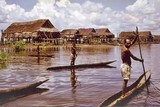 |
|
Kambarumba, Sepik Area, 1970. his village is just off the main Sepik River, near Ambunti. |
Go on to Part 2.
|




























